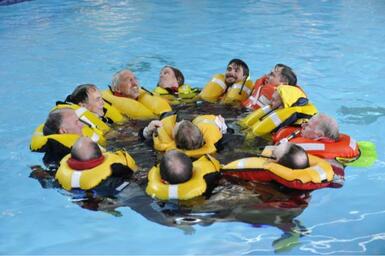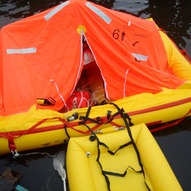The Offshore Personal Survival™ seminar
The SeaSurvival offshore personal survival™ seminar is approved by Sail Canada and World Sailing and it is recognized around the globe as a premier safety at sea event for cruisers and racers.
The seminar consists of 16 hours of programming covered during two days of instruction. The content includes both theory, table top and experiential practical exercises. The theoretical content is broadly divided between heavy weather seamanship and emergency preparedness, abandoning ship, and survival after abandoning ship.
The experiential components include pyrotechnical distress signalling and approximately two hours of wet drills in a pool.
The seminar consists of 16 hours of programming covered during two days of instruction. The content includes both theory, table top and experiential practical exercises. The theoretical content is broadly divided between heavy weather seamanship and emergency preparedness, abandoning ship, and survival after abandoning ship.
The experiential components include pyrotechnical distress signalling and approximately two hours of wet drills in a pool.
General course information
The level of offshore sailing experience in the classroom can range from novice sailors to industry professionals, often side by side. Because the seminar is responsive, interactive and participant engagement tends to be high no two seminars are ever exactly the same. When you take the seminar you are joining a network of over 1000 alumni who contribute and inform a unique cycle of continuous improvement through their cumulative participation and sharing of their offshore experiences.
Approximately 1 week before each seminar event specific instructions are sent to participants. These include start and stop times, rally points, and reminders on what to wear.
Some elements are common to all courses. Meals are not included. Breaks to eat are always provided.
Some elements are common to all courses. Meals are not included. Breaks to eat are always provided.
What to wear
For wet drills the recommended dress is your own foul weather gear and your own life jacket. For many, the wet drills are the first if not only time they will test their own life saving equipment in the water. It is a great opportunity to discover how well or not well your own equipment fits and functions and to what level it meets your expectations or it does not. We do have a limited supply of inflatable vests to loan however you will not be wearing our vest if you ever find yourself in the water. The minimum acceptable dress for the pool is a long sleeve shirt and pants and some kind of footwear like crocs, running shoes or boots to swim with. A bathing suit is not suitable attire and brings no training value to the exercises.
Sometimes the availability of access to the local pool will be in the at the beginning or middle of a training day. In this case you should always bring a warm change of clothes to return to the classroom.
For wet drills the recommended dress is your own foul weather gear and your own life jacket. For many, the wet drills are the first if not only time they will test their own life saving equipment in the water. It is a great opportunity to discover how well or not well your own equipment fits and functions and to what level it meets your expectations or it does not. We do have a limited supply of inflatable vests to loan however you will not be wearing our vest if you ever find yourself in the water. The minimum acceptable dress for the pool is a long sleeve shirt and pants and some kind of footwear like crocs, running shoes or boots to swim with. A bathing suit is not suitable attire and brings no training value to the exercises.
Sometimes the availability of access to the local pool will be in the at the beginning or middle of a training day. In this case you should always bring a warm change of clothes to return to the classroom.

Depending on the pool you may expect to perform any one or all of the following wet drills at your seminar:
- swim the length of an Olympic sized pool unaided without a life jacket
- tread water in the middle of a pool for 2 minutes without a life jacket
- don a life jacket thrown to you in the middle of the pool
- orally inflate a life jacket on your person in the water
- tow a survivor the length of the pool in life jackets
- float in the HELP position
- jump from height (like a diving board) and manually activate CO2 to inflate your life jacket in the water
- make interlocking rings of survivors in the water
- swim the length of an Olympic sized pool unaided without a life jacket
- tread water in the middle of a pool for 2 minutes without a life jacket
- don a life jacket thrown to you in the middle of the pool
- orally inflate a life jacket on your person in the water
- tow a survivor the length of the pool in life jackets
- float in the HELP position
- jump from height (like a diving board) and manually activate CO2 to inflate your life jacket in the water
- make interlocking rings of survivors in the water

Additionally, you should expect to do life raft drills that may include:
- launch and inflate a 6/8/10 person life raft
- right a capsized life raft unaided wearing a life jacket
- board a life raft unaided wearing a life jacket
- assist survivors to board a life raft
- life raft initial action drills
- distress signalling
- secondary drills
- launch and inflate a 6/8/10 person life raft
- right a capsized life raft unaided wearing a life jacket
- board a life raft unaided wearing a life jacket
- assist survivors to board a life raft
- life raft initial action drills
- distress signalling
- secondary drills
Seminar Syllabus
The content of the seminar changes as members and stakeholders contribute to keep the content current. Further, depending on the unique needs of any particular group more emphasis may be placed in specific areas. Generally the syllabus closely resembles the content listed below
The content of the seminar changes as members and stakeholders contribute to keep the content current. Further, depending on the unique needs of any particular group more emphasis may be placed in specific areas. Generally the syllabus closely resembles the content listed below
|
Introduction
Causes of Marine Emergencies Anatomy of an accident Principles of Survival Principles of survival at sea for the boat and crew General precautions Damage Prevention Planning Equipment Crew briefs Emergency instructions and standard procedures Care and maintenance of safety equipment Personal Lifesaving Appliances Lifebuoys PFDs Harnesses and Tethers Personal clothing Personal beacons Personal lights/strobes Other items Areas of Risk and Emergencies Preparation for rough weather Rough and severe weather strategies including: Boat handling Assessment options Crew routines Damage prevention, control and repair Use of storm equipment including: Drogues Storm sails Galley operations Emergencies and Strategies to address: Disabled vessel/severe damage Loss of mast Loss of rudder/steering Loss of keel Fire Man overboard Flooding Capsize/knock-down Giving assistance to other craft Abandoning Ship (Life rafts) - Preparation & planning for "The Last Resort" Decision to abandon ship as last resort Personal preparation (including donning of PFD, clothing, harness) Crew duties - Procedures and responsibilities Grab bags and extra items Launching of survival craft Boarding survival craft from vessel and water Entering the water wearing a PFD Survival techniques in the water Life raft construction, function, standards, and recommended Initial actions upon on boarding life raft Deployment of drogue Assisting injured persons and survivors into the life raft Deploying EPIRB Dangers to survivors Best use of life raft facilities Righting an inverted life raft Maneuvering life raft Need to maintain watch Psychology of survival Physiology of survival |
Initial actions upon on boarding life raft
Deployment of drogue Assisting injured persons and survivors into the life raft Deploying EPIRB Dangers to survivors Best use of life raft facilities Righting an inverted life raft Maneuvering life raft Need to maintain watch Psychology of survival Physiology of survival Use of Pyrotechnics Types and purposes Firing/ignition mechanisms Hazards & dangers of use Search and Rescue Search and Rescue authorities and agencies Communications -air rescue, sea rescue Need to assist rescue -flares, warnings about their use, EPIRBs, distress signals, smoke, communication Search procedures and patterns Overhead rescue from vessel/raft/water Rescue by surface vessels Fire Prevention & Fire Fighting Fire Theory Prevention/equipment - fire extinguishers, fire blankets, serviced, tested, maintained Methods Emergency Communications Marine Radio Certificate -2 members of crew VHF -listening watch, handhelds GMDSS Satcom First Aid and Early Management of Injury or Illness Senior First Aid -2 members of crew Injury or illness Hypothermia Seasickness Medical assistance -medical kit, extra medication, waterproof containers Weather The heat engine Clouds Fronts Severe weather Forecasting The duty of care Duty of Care of Owners/Skippers Importance of keeping records Training and periodic practice - long overnight races in preparation |
